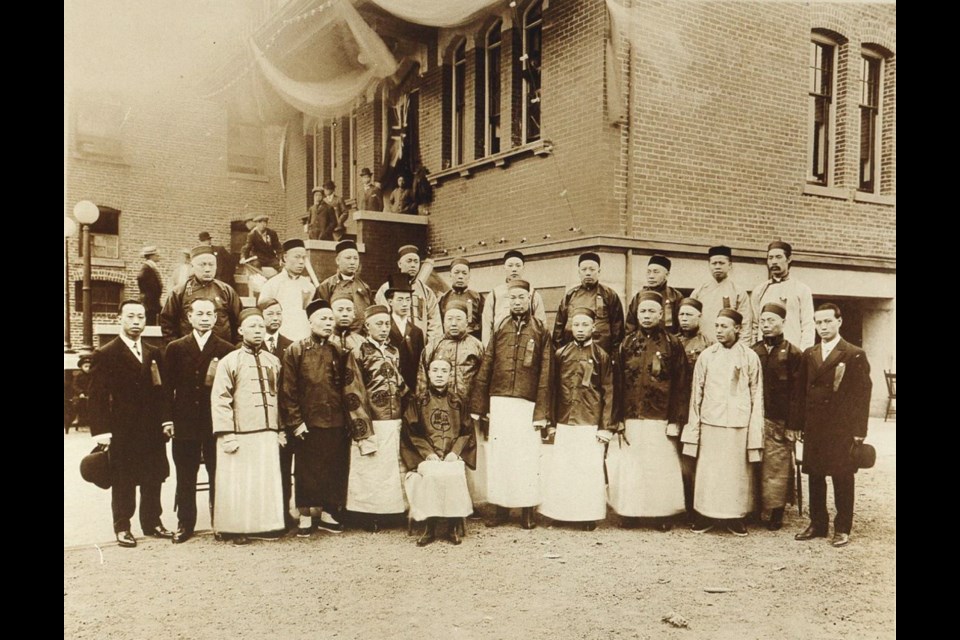In this excerpt from Inside Chinatown: Ancient Culture in a New World, Robert Amos and Kileasa Wong write about the history of Victoria’s Chinese Public School and take us inside the building that stands at 636 Fisgard St.
��
The Chinese Public School, or Huaqiao Gongli Xuexiao, is funded and operated by the Chinese Consolidated Benevolent Association. The first Chinese school in sa���ʴ�ý, tracing its origins to 1899, it offers Chinese language and cultural studies to both Chinese and non-Chinese children. The school building is also the headquarters of the CCBA, and continues to be a focal point for the Chinese community in Victoria.
From the start, the Chinese in Victoria were very proud of their highly developed culture, its values and traditions, and wanted to protect their children from assimilation and Westernization. In 1898, Lee Mon Gow, then president of the CCBA, convened a group to set up a school to teach these values to the children. It was called the Lequn Yishu Chinese School and was located on the second floor of the CCBA building at 560 Fisgard Street.
The school opened in 1899 with two classrooms. Lequn Yishu can be translated as “to enjoy the company of a free school.” Once the school was established, Lee Mon Gow became its principal, a position he held for 11 years. Lee was responsible for hiring teachers, and he brought them directly from China.
At that time, the Chinese often wore traditional clothing and maintained their Chinese culture through their cuisine and their shops. Most of the immigrants lived in Chinatown, and their children were afraid to play outside the community due to threats of bullying and harassment.
In 1901, for political reasons, the Victoria School Board withdrew permission for Chinese children to attend public school. The CCBA and community members opposed this discrimination, and a court case against the exclusion was fought valiantly by lawyer Fred Peters, hired by the CCBA. He was so committed to the anti-discrimination position that, when the case was lost, he returned to the CCBA most of the money they had collected for his fee
Excluded from the public schools, an increasing number of students had to be accommodated at the Lequn Yishu school. On Aug. 8, 1908, the CCBA purchased land at 636 Fisgard St. on which to build a new school. A partial lot at 640 Fisgard, the side yard of the home of Lee Mon Gow, was donated to become the school’s playground.
When the school moved, with a grand opening on Aug. 7, 1909, it was given a new name: Daqing Qiaomin Gongli Xuetang (Greater Qing Imperial Overseas Residents Public School). It was a proud occasion for the community. The new school received a wide variety of gifts, including cash donations, lighting, clocks, maps, globes, chairs and desks, many of which are still part of the school’s equipment.
The original curriculum of the school was continued, with Chinese as the language of instruction, but English was soon added, to help students pass the English examination for entering public schools. In 1911, with the election of a new school board, Chinese children were allowed to return to public schools.
After the fall of the Qing Dynasty in 1911, the school had to be renamed to match the new republic and in 1912 it became Huaqiao Gongli Xuexiao (Overseas Chinese Public School). The first graduation ceremony took place in February 1915, with 12 graduates. The current student population is almost 250.
In 1921, the provincial Ministry of Education decided to segregate Chinese and white students, banishing more than 400��Chinese students from their usual elementary schools and gathering them in old huts at King’s Road and Rock Bay. In reaction, the CCBA and others arranged that the students would walk out in protest. The Chinese consulate in Ottawa also appealed the government’s policy.
It took three years and considerable further lobbying before the provincial government changed the law but, ironically, just as the new federal law stopped all Chinese immigration.
The commitment and attitude of the parents and children to Huaqiao Gongli Xuexiao is noteworthy. The students attend regular public school until 3 p.m. and then go to Chinese school. School is in session from 4 to 6 p.m. weekdays, and is open on Saturdays from 9 a.m. to 4 p.m. for a different group of students. It is organized as an elementary school, with six grades. In Grade��1, students begin learning how to read and write simple characters. By Grade 6 they are able to write short essays and read Chinese newspapers.
The majority of the Chinese people in Victoria are from Canton, so the official language of the community is Cantonese. Both Cantonese and Mandarin Chinese are written the same way but pronounced differently. In September 1998, the school added Mandarin studies for Grades 5 and 6.
In addition to their academic studies, the students are constantly at work on cultural projects. Calligraphy is integrated into the study of reading and writing. Under Principal Wu, herself a talented painter, they produce pictures with seasonal motifs throughout the year.
The long and honourable tradition of dance at the school has now reached new heights, with both senior and junior folk dance troupes winning acclaim and prizes locally and internationally. As well, a junior lion dance team sometimes trains under the senior lion dancers at the Sheung Wong Kung-fu Club.
Excerpt from: Inside Chinatown: Ancient Culture in a New World by Robert Amos and Kileasa Wong, TouchWood Editions © 2009 Robert Amos and Kileasa Wong.



